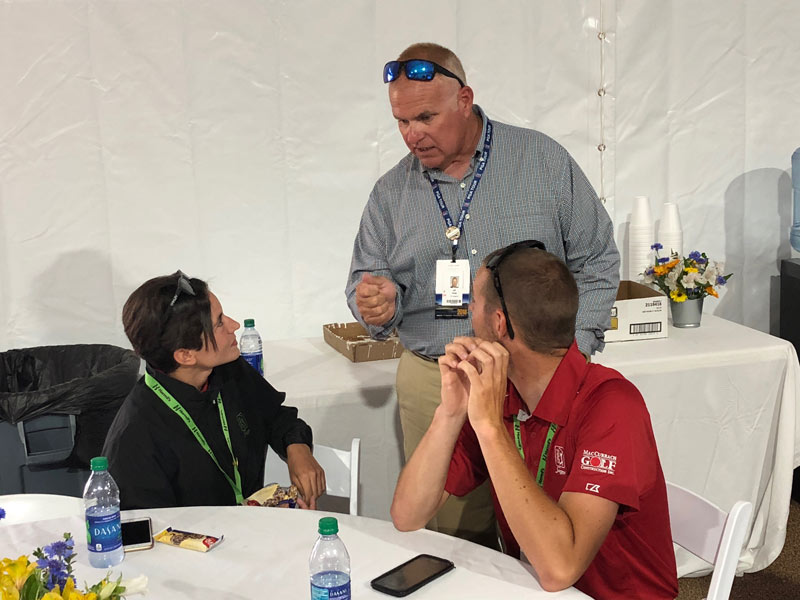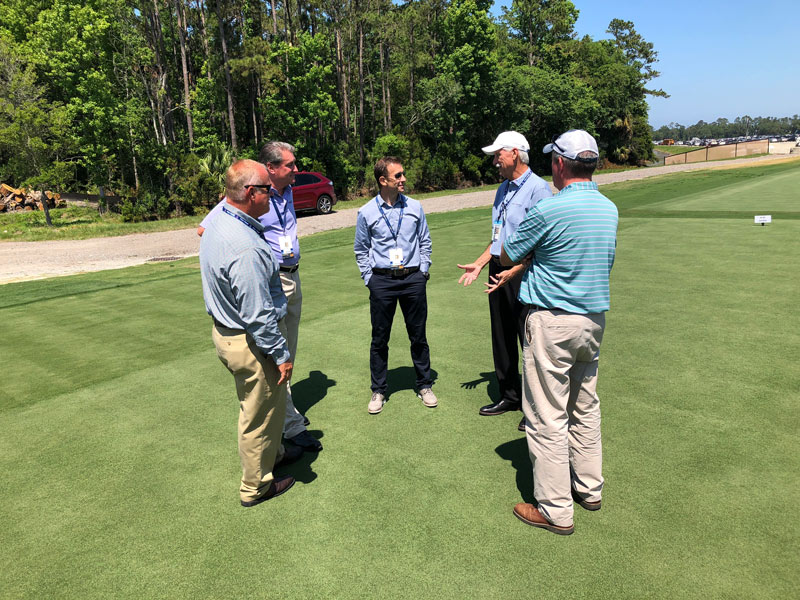
Jeff Plotts, CGCS, director of golf course operations at TPC Sawgrass, chats with maintenance team members prior to Tuesday evening’s rounds in advance of The Players. Photos by Scott Hollister
Maybe it’s luck. Maybe it’s a product of that vital mix of experience and preparation. And maybe it’s just a case of the golf course management gods throwing them a bone.
Whatever the circumstance, the team at TPC Sawgrass and the facility’s Stadium Course couldn’t be in a much better place on the eve of the 2018 edition of The Players. Course conditions are dialed-in, the weather is cooperating, and the 160-plus volunteers and full-time staffers have quickly taken to their assigned tasks.
It’s all systems go, at least in the eyes of Jeff Plotts, CGCS, the director of golf course operations at Sawgrass.
“Everything is really going according to plan, at least in my mind,” said a relaxed Plotts on a warm and sunny Tuesday afternoon in Ponte Vedra Beach, Fla. “We’re going to have to keep an eye on the wind so the greens don’t get too quick on us. But that’s my only worry now, and it’s not really much of a worry.”
That only seems appropriate, considering that next year’s event promises to present plenty of changes — and challenges — to the way Plotts, Stadium Course superintendent Lucas Andrews and the team at Sawgrass gear up for The Players. That’s because the tournament is moving from May to March — the week of March 12, to be exact — as part of a change to golf’s overall schedule triggered largely by the move of the PGA Championship from August to May.
At Sawgrass, that means that instead of playing on bermudagrass in the early part of its growing season like they are this week, the world’s best players will be tackling a fully overseeded golf course the next time they come to town. It also means Mother Nature will likely play a much more prominent role than she does in May. This past March, for example, was unseasonably cold and wet in North Florida, which would obviously test the agronomic mettle of Plotts, Andrews and the entire PGA Tour agronomy team.
When next year’s tournament week rolled around this year, the agronomy team at Sawgrass didn’t pass up the opportunity to put a few practices and procedures to the test, simply to see whether they could pick up any lessons they could apply after the schedule change becomes a reality. And beyond the big-picture takeaways from those experiments, there were some smaller-picture issues they focused on as well.
“We tried to pay particularly close attention to things like our trees, to try and understand with the live oaks we have what the leaves are doing at that time of year, just trying to understand what the leaf litter will be and how challenging that will be for our team,” says Plotts, a 24-year GCSAA member. “We watched how our landscapes were flowering and coming out of winter, what challenges we were going to face there to make the facility look its best.
“It’s going to be different, no doubt. We’re going to have to kind of learn as we go, so we just thought anything at all we could learn this year about that process would get us one step closer come next year.”

From left: Plotts; GCSAA President Darren J. Davis, CGCS; GCSAA CEO Rhett Evans; Cal Roth, senior vice president of agronomy for the PGA Tour; and Mark Johnson, a regional agronomist for the PGA Tour, check out the massive nursery green at TPC Sawgrass on Tuesday.
But the schedule change won’t be all twists and turns that the agronomy team at Sawgrass has to overcome. The earlier date also presents some opportunities as well.
“I think the biggest thing that most superintendents will identify with is the opportunity to have growing turf as we’re preparing for the tournament,” Plotts says. “Even in early May, we don’t have fully growing turf. We’re playing professional golf on it, beating it up a little bit, and we’re still really at the mercy of what Mother Nature provides us. Having some overseed there and the ability to have some growing turf through the winter months, something that will better tolerate the wear and tear we get, will be beneficial for us.”
Regardless of timing, the one thing that The Players and the Sawgrass agronomy team have always benefited from — and will almost certainly continue to benefit from — is overwhelming support from all corners of the golf course management industry. Whether that comes from industry suppliers, GCSAA, the PGA Tour or volunteers who come to help from all over the country and around the world — there is a sizable international contingency on hand this week — Plotts is quick to acknowledge the role that support plays in the success of The Players.
“It’s obvious that you can’t put on an event of this magnitude without help. And you just look around here, you see just how supportive everyone is and how much of a family that this industry is,” Plotts says.
“You’ve got superintendents from all over the globe that are willing to come here and lend a hand, take their own vacation time, be away from their families, get up crazy early and stay up crazy late, all to help us out. It shows just how strong golf is. It’s pretty humbling to work with people like that.”
Scott Hollister is GCM’s editor-in-chief.